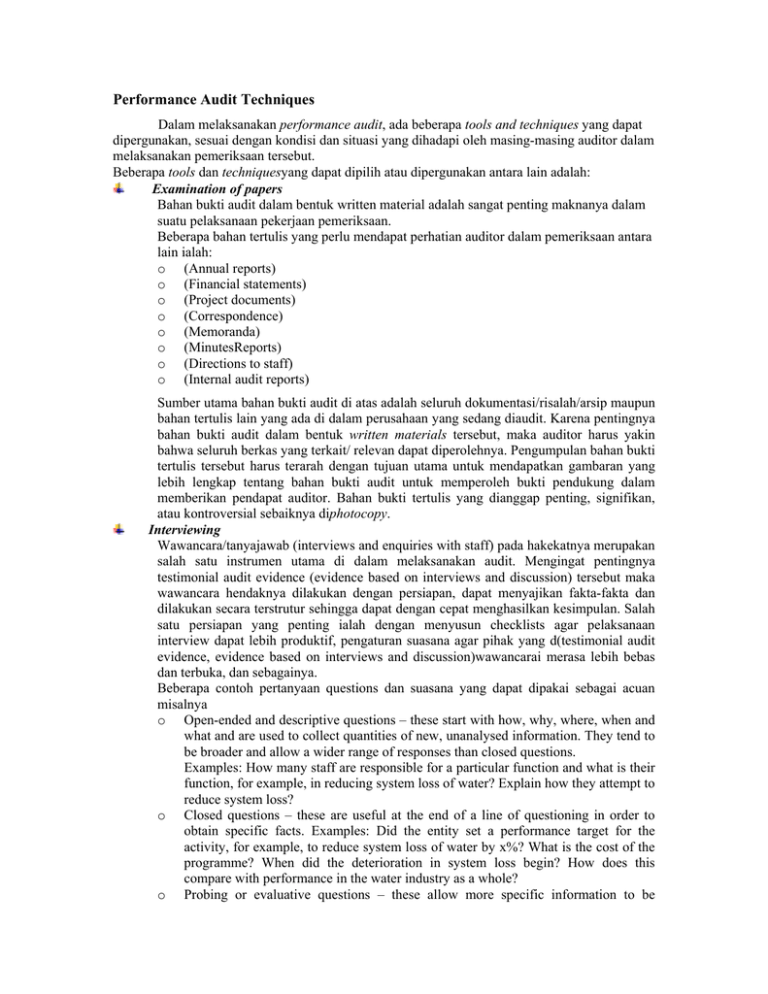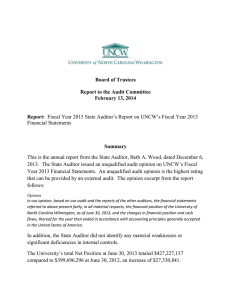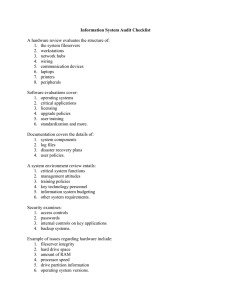Performance Audit Techniques
advertisement

Performance Audit Techniques Dalam melaksanakan performance audit, ada beberapa tools and techniques yang dapat dipergunakan, sesuai dengan kondisi dan situasi yang dihadapi oleh masing-masing auditor dalam melaksanakan pemeriksaan tersebut. Beberapa tools dan techniquesyang dapat dipilih atau dipergunakan antara lain adalah: Examination of papers Bahan bukti audit dalam bentuk written material adalah sangat penting maknanya dalam suatu pelaksanaan pekerjaan pemeriksaan. Beberapa bahan tertulis yang perlu mendapat perhatian auditor dalam pemeriksaan antara lain ialah: o (Annual reports) o (Financial statements) o (Project documents) o (Correspondence) o (Memoranda) o (MinutesReports) o (Directions to staff) o (Internal audit reports) Sumber utama bahan bukti audit di atas adalah seluruh dokumentasi/risalah/arsip maupun bahan tertulis lain yang ada di dalam perusahaan yang sedang diaudit. Karena pentingnya bahan bukti audit dalam bentuk written materials tersebut, maka auditor harus yakin bahwa seluruh berkas yang terkait/ relevan dapat diperolehnya. Pengumpulan bahan bukti tertulis tersebut harus terarah dengan tujuan utama untuk mendapatkan gambaran yang lebih lengkap tentang bahan bukti audit untuk memperoleh bukti pendukung dalam memberikan pendapat auditor. Bahan bukti tertulis yang dianggap penting, signifikan, atau kontroversial sebaiknya diphotocopy. Interviewing Wawancara/tanyajawab (interviews and enquiries with staff) pada hakekatnya merupakan salah satu instrumen utama di dalam melaksanakan audit. Mengingat pentingnya testimonial audit evidence (evidence based on interviews and discussion) tersebut maka wawancara hendaknya dilakukan dengan persiapan, dapat menyajikan fakta-fakta dan dilakukan secara terstrutur sehingga dapat dengan cepat menghasilkan kesimpulan. Salah satu persiapan yang penting ialah dengan menyusun checklists agar pelaksanaan interview dapat lebih produktif, pengaturan suasana agar pihak yang d(testimonial audit evidence, evidence based on interviews and discussion)wawancarai merasa lebih bebas dan terbuka, dan sebagainya. Beberapa contoh pertanyaan questions dan suasana yang dapat dipakai sebagai acuan misalnya o Open-ended and descriptive questions – these start with how, why, where, when and what and are used to collect quantities of new, unanalysed information. They tend to be broader and allow a wider range of responses than closed questions. Examples: How many staff are responsible for a particular function and what is their function, for example, in reducing system loss of water? Explain how they attempt to reduce system loss? o Closed questions – these are useful at the end of a line of questioning in order to obtain specific facts. Examples: Did the entity set a performance target for the activity, for example, to reduce system loss of water by x%? What is the cost of the programme? When did the deterioration in system loss begin? How does this compare with performance in the water industry as a whole? o Probing or evaluative questions – these allow more specific information to be obtained and to check for depth of knowledge and experience. They are also used to fill in gaps in the interviewer’s knowledge about the area or topic and inform much of an audit or’s performance audit work. Examples: Was the target for reduction in system loss achieved? If not, what may have been the reasons? What action was taken to ensure that the target was achieved? What difference did the programme make towards preventing system loss? o 4.8 It is advisable to avoid: Multiple questions – this suggests that the interviewer doesn’t really know what the issues are or what he/she is trying to find out. Questions should be properly planned and thought through. ?? Leading or suggestive questions – these tend to put pressure on respondents to answer in a particular way. They may provide answers that the interviewer may wish to hear but they could not be regarded as proper evidence. Vague questions – the interviewer must be clear on the information being sought and what he wishes to find out. Hypothetical questions – these may only produce hypothetical answers that cannot be used as proper evidence. Catatan: In order to help with recollection, notes should be taken during each interview and written up as soon as possible afterwards. If the oral evidence is of particular significance to the examination, the record of the interview should be confirmed with the person interviewed. Direct observation One of the best ways of following and understanding what is actually going on is by direct observation of activities. Techniques such as these help the auditor to obtain evidence about physical assets and can be helpful in gathering evidence about whether people are following the proper procedures. By observing carefully, auditors try to formulate their first-hand opinion about the activity or behaviour under study. Inspection of processes while they are in operation will give the auditor sufficient understanding and credibility when discussing issues with the audited entity. It should be remembered, however, that a single observation could not be used to draw conclusions about matters that have occurred over a period of time. Points to keep in mind when observing activities directly include the following: o Approach the observation in a common-sense way and make it active, rather than theoretical o When being introduced to the staff directly involved, the auditor should explain tactfully what he is trying to achieve by observing the activity o The auditor must try not to upset the normal flow of work, or people’s behaviour, by getting in the way. The observers should try to understand the role of the participants in the procedure, trying to obtain knowledge of the activity as an insider, yet keeping their status as an objective observer o Everything which is observed should be carefully recorded since it may become key evidence o Take note of informal comments made when staff gain the confidence of the auditor (but be careful when staff simply make complaints). The evidence must be able to withstand scrutiny. Benchmarking The aim of benchmarking is to determine, through comparisons with performance or good practice elsewhere, whether there is scope for better performance. Comparisons can be made with other branches or units within the entity or with other relevant external organisations at home or abroad. The aim is to determine whether, by comparison with good practice elsewhere, there is scope for doing things better. This technique can help to identify opportunities to improve efficiency and make savings. High-level comparisons can be made with other organisations carrying out the same function. Example : schools, hospitals or administrative units or offices throughout the country. Performance benchmarking uses a range of measures and indicators to compare performance. Areas covered include productivity, unit costs and quality of service. Examples: pupil-teacher ratios, patients treated by hospitals, job placements achieved and unit cost of training provided. Use of the benchmarking technique can stimulate entities to improve their performance. However, in making comparisons, it is important to ensure that: o like is being compared with like (large entities may operate in different circumstances from smaller ones and comparisons may be unfair) o the method of collection of the data should be consistent o auditee entities are not permitted to accept favorable comparisons but reject others. Case studies For performance audit, case examination is an effective way of obtaining, analysing and presenting information. Case studies refer to the in-depth examination of a representative selection of events, transactions or items in order to understand and measure a programme or activity as a whole. The method focuses on assessing efficiency of various services by analysing a sample of cases to obtain an insight into the precise workings of an activity. Example : In the income tax department, the auditor may take a sample of income tax assessments to evaluate the response time of the department to letters received from taxpayers. Data would be tabulated to show dates on which letters were received and processed and the dates of replies. Case studies must, however, be chosen with care if they are to make a useful contribution to the performance review. Areas where case studies may be useful include: o inconsistent performance between different institutions e.g. hospitals catering o sales of government land, buildings etc. to ensure the best price o management of space in hospitals, schools etc. to ensure optimal use o project management o quality of service o maintenance of vehicles Questionnaires Questionnaires comprise lists of questions designed to obtain information on a specific subject. When the cost of interviewing a large number of people would be prohibitive, questionnaires are a valuable means of gathering information. They are often used to assess quality of service or the scope for improvements in service delivery. Questionnaires need to be structured to meet the needs of the situation and they can be suitable in circumstances where: o there is a need to minimise the time and cost involved in collecting information o the information is not otherwise available o the auditor is trying to identify strengths and weaknesses in an organisation o an assessment of quality of service is being made on the basis of ratings given by customers o audit evidence is required to support particular conclusions from the study. The design of questionnaires will have a direct impact on the quality of evidence obtained and is therefore particularly important. They need to be straightforward to complete, otherwise they will be avoided by potential respondents. Confidential, non-attributable questionnaires are more likely to encourage completion by respondents. Surveys Conducting a survey is a useful method of collecting new or standardised information, both quantitative and qualitative, from a number of respondents in an audit area. The main quantitative survey methods are postal (self-completion) questionnaires, personal interviewing and telephone interviewing. VFM studies can make good use of surveys to produce new insights and up-to-date evidence. They must be well planned, designed and implemented if the information obtained is to be useful and reliable. Where it is planned to organise a survey, auditors should seek professional assistance in drawing up the survey, conducting it and analysing the results. Focus groups A focus group is a selection of people, often stakeholders or customers of an entity, brought together to discuss specific topics or issues. A focus group of about 15 to 20 people is an ideal size for free discussion. Since much of VFM work is about the impact of government programmes on a wide range of people, focus groups can have a useful part to play. They are often used to collect information and produce results that allow respondents to express views in their own words and context. Customers’ views of services are often required as well as those of the providers of government programmes. Focus groups do, however, only produce qualitative data and, therefore, considerable expertise is required in their interpretation. Flow charting Flow-charting refers to the gathering of information on specific processes or activities within an entity. The flow chart is a visual aid to the sequential processes in the flow of transactions in the organisation or process. Breaking down an activity into a flow chart can help to focus on the main features of an activity. It also helps in designing the methodologies to be used in the audit, for example, whether to use techniques such as surveys or benchmarking. Activity Analysis Activity analysis refers to the identification, measurement and analysis (in terms of time, cost and throughput) of the activities undertaken by people in an organisation. This analysis is useful when trying to measure objectively the contribution made by an activity and by those carrying it out. Although the technique can be useful in providing cost-effective information about working activities, the measurement of activities may meet resistance from the staff involved. Statistical analysis Statistical analysis is often employed when data has to be analysed in order to establish trends or make comparisons. Statistics is concerned with the collection of data, its organisation, presentation and analysis. To investigate the characteristics of a particular group of individuals, objects or activities (called the “population”), a sample is taken and the values of the variables to be investigated is established. Statistical analysis can be helpful in measuring performance and ensuring that any analysis and interpretation of the data supporting the recommendations and conclusions is sound. A basic understanding of probability theory will help in carrying out statistical analyses. Presentation of the statistical data is also important in explaining complex data. 4.24 Software packages can make an important contribution, particularly in collecting and sorting data, analysing and interpreting it and in presenting the results. Work study The principal objective of the work study function is to ensure that the area under study is providing value for money. It is a technique that examines work processes to see if working methods and standards can be improved. By measuring productivity (the relationship between input and output), work study has resulted in considerable benefits when applied to high volume, repetitive tasks. Work study can be used, for example, to highlight poor office practices and to improve working methods and procedures for clerical functions. Cost benefit analysis Cost benefit analysis is the most comprehensive form of economic appraisal. It seeks to quantify in money terms as many of the costs (inputs) and benefits (outputs) of a proposal as possible, including those for which the market does not provide a satisfactory measure of economic value. Cost benefit analysis need not be restricted to appraisal, since it can also be carried out after the event. In performance audit, it can be valuable to examine the original cost benefit appraisal to see whether the actual cost in comparison with the benefits achieved still represents value for money. Reasons for failure to contain the estimated costs or to achieve the predicted benefits can be probed as part of a performance audit.



